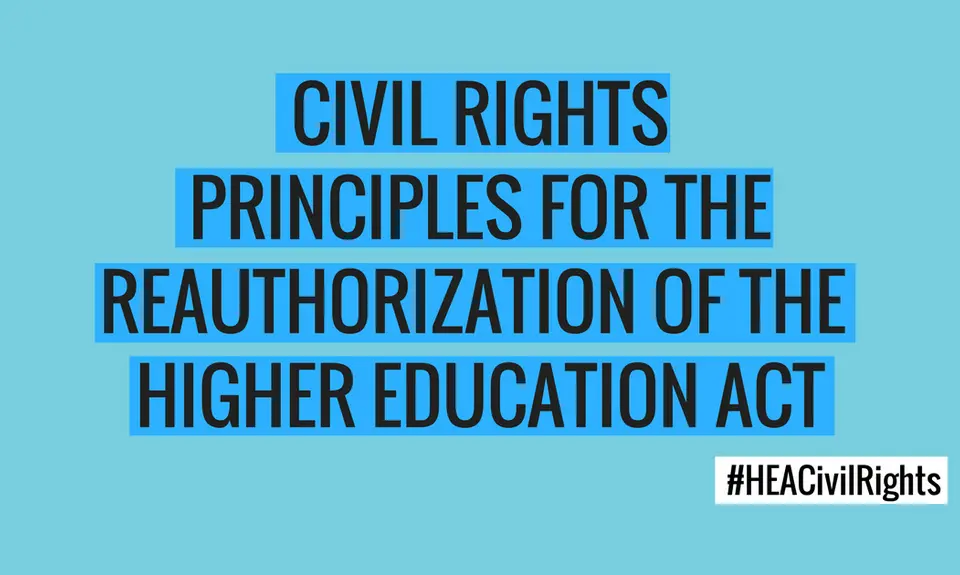Since 1965, the Higher Education Act (HEA) has helped students from marginalized communities access educational opportunities. With HEA reauthorization on Congress' to-do list, People For the American Way and nearly 50 organizational allies are calling for the inclusion of critical civil rights principles that will ensure a lasting HEA legacy for students of color, women and LGBTQ students, and many others. PFAW and the HEA civil rights coalition believe that Congress must account for not only broad civil rights enforcement but also equitable enrollment policies, affordability, and accountability. You can download our 10-point platform here.
The Higher Education Act was first passed in 1965, during the height of the civil rights movement, in response to demands from low-income communities and communities of color that the federal government do more to open the doors to higher education and enable students to attain the education and degrees they knew would mean economic, social, and political opportunity in the United States. While some challenges remain the same, new challenges have arisen in the 50 years since the law was first passed. The fundamental desire of communities, however, and the obligation of the federal government to assist, remain the same. It is in this spirit that we offer the following principles that must be included in a reauthorization of the Higher Education Act if we’re going to strengthen and build a higher education system that provides equitable access to and success in a high-quality postsecondary education for all students, especially for those students who have historically experienced and continue to experience barriers to success in higher education.
To fulfill the civil rights promise and intent of the Higher Education Act, any reauthorization must:
- Ensure robust implementation and enforcement of civil rights laws across all postsecondary institutions that accept federal funds and ensure federal funds only go towards institutions that do not discriminate based on race, color, national origin (including religion, language, ethnic characteristics, and immigration status), sex (including pregnancy status, family status, sexual orientation, and gender identity), disability, or age.
- Remove barriers to enrollment and promote meaningful access for historically marginalized students (including students of color, Native students, low-income students, English learners, students with disabilities, adult learners, pregnant and parenting students, opportunity youth, immigrant students, LGBTQ students, homeless students, youth in or exiting foster care, currently incarcerated individuals and individuals who have had prior contact with the justice system), including by providing for quality educator preparation so that students are prepared for success after K-12, and address barriers in access to a post-secondary education caused by historic and present-day race-based exclusionary policies and practices.
- Increase student persistence in and completion of a quality, racially equitable postsecondary education, such that students who enroll will have meaningful access to all aspects of student life and the support they need to succeed. Increase culturally competent wrap around support services such as academic advising, counseling, mental health services, and child and family care services.
- Make college affordable for low-income students and ensure that federal student aid takes into account the totality of a family's economic circumstances and full college cost, which may include child care, transportation, and housing, and prioritize investments in grant aid first to reduce the disparate student loan debt burden placed on low-income students, first-generation students, women, and students of color.
- Provide for the collection and reporting of higher education data that is disaggregated, cross-tabulated, and broadly available without personally identifiable information and ensure that students and families have meaningful access to figures about programmatic quality, affordability, student borrowing, attendance costs, measures of student success, campus safety and climate, and investigations of the institution regarding fraudulent, abusive, and deceptive practices.
- Design accountability systems to ensure students receive value from their higher education, and not in a way that limits opportunity for or disincentivizes enrollment of low-income students or other students who might face greater barriers to degree completion. Create incentives to improve institutional quality by requiring that a majority of federal financial aid is spent on instruction and student supports and provide additional resources to non-profit and public institutions that serve large shares of low-income and historically marginalized students and that are actively working to provide the supports necessary to improve student outcomes. Ensure accountability is differentiated and takes into account an institution’s history, mission, and resources.
- Exclude for-profit colleges, including covert for-profit colleges masquerading as non-profit, from federal financial aid programs unless they have demonstrated their value to students through increased student earnings and they rely, at least partially, on non-federal sources of funding.
- Protect student loan borrowers from abusive and fraudulent practices and exploitation in the federal and private student loan servicing and debt collection markets and provide access to accurate and complete information about their loans, access to affordable repayment options, access to administrative loan discharges, and access to legal remedies if they need further relief.
- Ensure safe and inclusive campus climates free of harassment and violence, including sexual harassment, gender-based harassment and violence, and other forms of harassment and violence based on race, national origin, religion, disability, or any combination thereof, and ensure that campus programs, policies, and practices are inclusive, equitable, fair, and advance the safety and well-being of all students.
- Invest in and support institutions that serve high populations of traditionally underrepresented students, including Historically Black Colleges and Universities (HBCUs), Hispanic Serving Institutions (HSIs), Predominantly Black Institutions (PBIs), Tribal Colleges and Universities (TCUs), Alaska Native and Native Hawaiian-serving Institutions (ANNHIs), Native American-serving Nontribal Institutions (NASNTIs), and Asian American and Native American Pacific Islander Serving Institutions (AANAPISIs).
